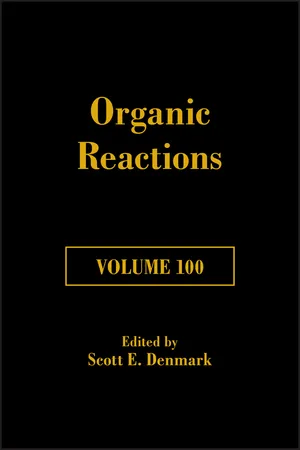
- English
- ePUB (mobile friendly)
- Available on iOS & Android
About This Book
Written by a "who is who" of leading organic chemists, this anniversary volume represent the Organic Reactions editors' choice of the most important, ground-breaking and versatile reactions in current organic synthesis. The 15 reaction types selected for this volume include reactions for carbon-carbon bond formation, cross-coupling reactions, hydro- and halofunctionalizations, among many others.
In line with the successful recipe of the series, each chapter is focused on a single reaction, discussing its mechanism and stereochemistry, scope and limitations, applications to synthesis, comparison with other methods, and experimental procedures. Each chapter concludes with a tabular survey of selected key application examples, complete with reported reaction conditions and yields, to serve as a quick reference guide for synthesis planning.
Frequently asked questions
Information
CHAPTER 1
THE NEGISHI CROSS‐COUPLING REACTION
CONTENTS
- Acknowledgements
- Introduction
- Mechanism and Stereochemistry
- Features of Palladium‐Catalyzed Reactions
- Effect of Additives and Solvents in Palladium‐Catalyzed Reactions
- Features of Nickel‐Catalyzed Reactions
- C(sp2) Coupling Partners
- Configurational Specificity of Alkenyl Electrophiles
- C(sp3) Coupling Partners
- Constitutional Site Selectivity of Secondary Alkylzinc Reagents
- Configurational Stability of Secondary Alkylzinc Reagents
- Scope and Limitations
- The Organozinc Reagents
- Alkylzinc Reagents
- Enantiospecific Cross‐Coupling Reactions of Alkyl Nucleophiles
- Enantioselective Cross‐Coupling Reactions of Alkyl Nucleophiles
- Alkenylzinc Reagents
- Alkynylzinc Reagents
- Aryl‐ and Heteroarylzinc Reagents
- Enantioselective Approaches Towards Chiral Biaryls
- Alkylzinc Reagents
- The Electrophile
- Alkyl Electrophiles
- Enantiospecific Cross‐Coupling Reactions of Alkyl Electrophiles
- Enantioselective Cross‐Coupling Reactions of Alkyl Electrophiles
- Desymmetrizing Cross‐Coupling Reactions of meso‐Anhydrides
- Cross‐Coupling Reactions of Allylic Electrophiles
- Alkenyl Electrophiles
- Alkynyl Electrophiles
- Aryl and Heteroaryl Electrophiles
- Acyl Electrophiles
- Alkyl Electrophiles
- The Organozinc Reagents
- Applications to Synthesis
- Overview
- Tetrapetalone A‐Me Aglycon.141
- Dehydromicrosclerodermin B
- (–)‐Daphenylline
- Negishi Cross‐Coupling in Flow
- Multi‐kg C(sp2)–C(sp3) Coupling
- Overview
- Comparison With Other Methods
- Experimental Conditions
- Preparation of Organozinc Reagents
- Transmetalation
- Oxidative Addition of Zn into Organohalides
- Cobalt Catalysis
- Direct Zinc‐Halogen Exchange
- Direct Zincation of (Hetero)arenes
- Synthesis of Bench‐Stable Organozinc Pivalates
- Reaction Conditions
- Catalysts
- Solvents
- Additives
- Preparation of Organozinc Reagents
- Experimental Procedures
-
- (S)‐N‐(Boc)‐Allylglycine Methyl Ester [Direct Insertion of Activated Zinc into an Alkyl Iodide and Cross‐Coupling with an Alkenyl Bromide].157
- (S)‐2‐(1‐Cyclohexylbutan‐2‐yl)naphthalene [Stereospecific Cross‐Coupling of an Alkylzinc Reagent with an Enantioenriched Electrophile].15
- tert‐Butyl 2,2,4‐Trimethyl‐5‐octadecyloxazolidine‐3‐carboxylate [Sequential One‐Pot Chemoselective C(sp3)–C(sp3) Cross‐Coupling of a Bifunctional α,ω‐Bromochloroalkane].50
- 5‐Methyl‐2,2′‐bipyridine [Lithium–Halogen Exchange and Transmetalation for the Cross‐Coupling of a Heteroaromatic Compound].158
-
- Tabular Survey
Acknowledgements
Introduction
Table of contents
- COVER
- TABLE OF CONTENTS
- “C”
- INTRODUCTION TO THE SERIES ROGER ADAMS, 1942
- INTRODUCTION TO THE SERIES SCOTT E. DENMARK, 2008
- PREFACE FOR VOLUME 100
- CHAPTER 1: THE NEGISHI CROSS‐COUPLING REACTION
- CHAPTER 2: GENERATION AND TRAPPING OF FUNCTIONALIZED ARYL‐ AND HETEROARYLMAGNESIUM AND ‐ZINC COMPOUNDS
- CHAPTER 3: Copper‐Catalyzed, Enantioselective Hydrofunctionalization of Alkenes
- CHAPTER 4: The Catalytic, Enantioselective Favorskii Reaction: in Situ Formation of Metal Alkynylides and Their Additions to Aldehydes
- CHAPTER 5: ENANTIOSELECTIVE LITHIATION–SUBSTITUTION OF NITROGEN‐CONTAINING HETEROCYCLES
- CHAPTER 6: CATALYTIC, ENANTIOSELECTIVE, TRANSFER HYDROGENATION
- CHAPTER 7: HYDROFUNCTIONALIZATION OF ALKENES BY HYDROGEN‐ATOM TRANSFER
- CHAPTER 8: CARBON–CARBON BOND FORMATION BY METALLAPHOTOREDOX CATALYSIS
- CHAPTER 9: SUZUKI–MIYAURA CROSS‐COUPLING
- CHAPTER 10: ‐DIRECTED C–H ALKYLATION OF SUBSTITUTED BENZENES
- CHAPTER 11: CATALYTIC, ENANTIOSELECTIVE, C–H FUNCTIONALIZATION TO FORM CARBON–CARBON BONDS
- CHAPTER 12: CATALYTIC, ENANTIOSELECTIVE FLUORINATION REACTIONS
- CHAPTER 13: CATALYST‐CONTROLLED GLYCOSYLATION
- CHAPTER 14: PALLADIUM‐CATALYZED AMINATION OF ARYL HALIDES
- CHAPTER 15: CATALYTIC, ENANTIOSELECTIVE, COPPER–BORYL ADDITIONS TO ALKENES
- CUMULATIVE CHAPTER TITLES BY VOLUME
- AUTHOR INDEX, VOLUMES 1-100
- CHAPTER AND TOPIC INDEX, VOLUMES 1–100
- END USER LICENSE AGREEMENT